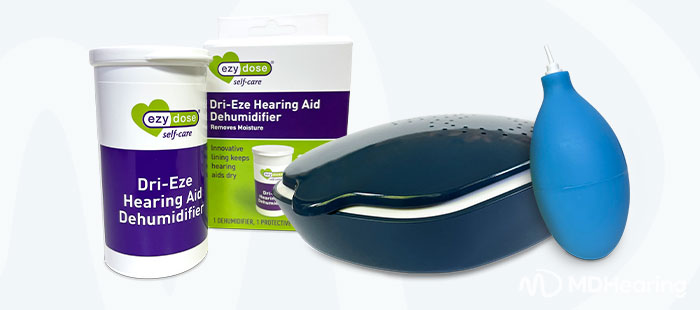Moisture is one of the biggest threats to your hearing aids—especially during hot, humid summer months or after a sweaty workout. Just like how condensation forms on a cold soda can when it hits warm, humid air, the same can happen inside your hearing aids. The tiny electronic components develop moisture, which can lead to performance issues, corrosion, or even permanent damage.
Fortunately, there’s an easy solution: a hearing aid dehumidifier. It’s a small but powerful tool that helps protect your investment and keeps your hearing aids working like new.
How Moisture Gets Into Your Hearing Aids
Moisture can sneak into your hearing aids in more ways than you might think. While obvious mishaps—like jumping into a pool or tossing your hearing aids into the laundry by accident—can definitely cause damage, everyday situations also pose a risk. Even natural humidity in the air or temperature changes can cause moisture to build up inside the delicate electronics of your devices.
Here are some common ways moisture gets in hearing aids:
- Sweating during exercise
- Humidity in the environment
- Condensation from moving between cold and warm areas
- Getting caught in the rain
- Water activities like boating or kayaking
- Using a sauna or shower
- Spraying hairspray or other styling products
Certain lifestyles and environments increase the risk. If you live in a humid climate like Florida, work in cold storage (like a walk-in freezer), or lead an active lifestyle, your hearing aids are especially vulnerable to moisture damage.
Threats That Moisture Poses to Hearing Aids
Moisture and humidity can be a hearing aid’s worst enemy—from affecting sound quality to causing total device failure. Even small amounts of humidity can harm the sensitive and expensive electronic parts of your hearing aids.
Here’s how moisture can cause problems:
- Condensation – When warm, humid air hits the cooler internal parts of your hearing aid, condensation forms—just like on a cold glass of water. As you can imagine, water and electronics don’t play well together. These tiny water droplets can interfere with the components and affect the sound quality.
- Corrosion – Condensation that sits on electronic components can cause corrosion. Over time, rust can form on batteries, cutting off power or leading to swelling that may damage the device.
- Electrical Shorts – While pure water isn't very conductive, the air and everyday moisture contains dust and other particles that do conduct electricity that can trigger electrical shorts.
- Complete Malfunction – If moisture isn’t removed, your hearing aids could stop working altogether, leading to costly repairs—or the need for a full replacement.
Products That Help Remove Moisture in Hearing Aids
To keep your hearing aids performing their best, it’s important to minimize exposure to moisture whenever possible. While avoiding humid or wet environments is a great first step, using a hearing aid dehumidifier daily is good practice for any hearing aid owner. Below, we’ll walk you through the most effective dehumidifying options—and explain how each one helps safeguard your devices.
Dehumidifier Jar
A hearing aid dehumidifier jar is a small, inexpensive container with a desiccant (drying agent) lining that absorbs moisture. This container requires no batteries or electricity—simply place your hearing aids in the dehumidifier jar before bed and close the lid. When used daily, this affordable product helps remove moisture, prevent costly repairs, and extend the life of your hearing aids.
UltraDry UV Dry Box
The UltraDry UV Dry Box is a simple-to-use, compact device that sanitizes your hearing aids in addition to drying them. This dual-function electric dryer uses gentle, dry heat to remove moisture, sweat, and condensation, while also sanitizing with ultraviolet (UV-C) light to eliminate harmful germs, bacteria, and viruses. The UltraDry UV Dry Box is a faster drying method than the dehumidifier jar—the cleaning cycle only takes about 4 hours. Simply place your hearing aids in the dry box, press the button to start the cleaning cycle, and close the lid.
Tubing Air Blower
A tubing air blower is a special bulb designed for behind-the-ear (BTE) hearing aids. This tool creates pressure through the hearing aid tubing to dislodge any moisture, ear wax, and debris that can become trapped and migrate to your hearing aid. For best results, use this product weekly to blow out debris and dry the tubing.
Alternative Hearing Aid Dehumidifiers
If you’re caught without a hearing aid dehumidifier, there are a couple of temporary solutions you can try. Silica gel packets (the kind you find in shoeboxes, medication bottles, or electronics packaging) can help in a pinch. These packets contain tiny silicon dioxide beads that absorb moisture effectively. As a last resort, uncooked white rice can also help draw out moisture. Simply place your hearing aids in a sealed container with a cup of dry rice overnight.
While these alternative methods can offer short-term relief, they’re no substitute for a proper hearing aid dehumidifier. Use them only until you’re able to get a more reliable solution.
Protection Plans
Many hearing aid companies offer the option to purchase a protection plan to safeguard your investment. MDHearing’s Protection Plan Subscription provides coverage for all types of accidental damage, including water damage and corrosion. If your hearing aids can’t be fixed, then MDHearing will replace them.
Importance of Cleaning Hearing Aids Daily
While dehumidifiers can help protect your hearing aids, it’s still essential to have good daily cleaning habits. Because hearing aids are so small, it’s easy for them to get clogged by dirt, oils, and earwax. Keeping your hearing aids clean prevents these other threats from blocking sound or getting to the sensitive electronic parts.
If your hearing aids aren't clean and moisture-free, you may notice:
- Faded or distorted sound quality
- Static or crackling noises
- Sounds frequently cut in and out
- Hearing aids sometimes work and sometimes don’t
Maintaining your hearing aids is easy. Gently use a wire/brush cleaning tool set to remove dust, earwax, and other debris from the hearing aid buttons, microphones, tips, and tubing. The hearing aid body can also be cleaned with a soft, dry cloth. Do not use water, alcohol, or other liquids as they can damage the hearing aid.
Get Help With Your Hearing Aids
Keeping up with daily cleanings and moisture removal will help keep your hearing aids working properly for years to come. A hearing aid dehumidifier makes the process quick and effortless. Otherwise, you may have to spend money to get your hearing aids repaired or order a brand new pair.
At MDHearing, we strive to ensure that everyone benefits from high-quality hearings at an affordable price. That’s why we cut out the middleman and pass the savings to you. We offer a line of FDA-registered hearing aids designed for mild to moderately-severe hearing loss. Each hearing aid is backed by our 45-day risk-free trial period. You also have the option of purchasing inexpensive hearing aid care accessories and a protection plan subscription.
Need to shop for hearing aid dehumidifiers and care?
BROWSE ACCESSORIES

